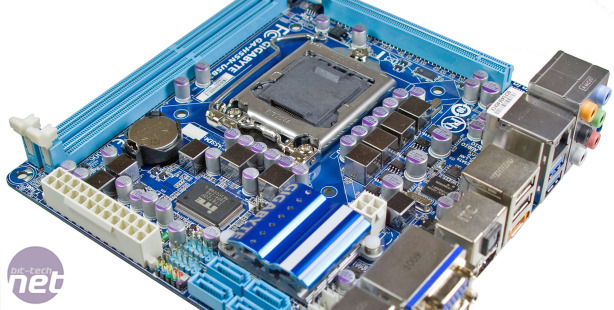
Performance Analysis
The comparative performance of the Gigabyte GA-H55N-USB3 (when we tested it with a Core i5-750 CPU) is very good - we consistently saw it at, or near, the top of our performance charts. Unfortunately the same can't be said in the gaming tests, which saw the H55N near the bottom of the performance pile.With the Core i5-661 in the socket, the performance of the H55N at stock speeds was pretty consistent versus other mini-ITX boards from ECS and Zotac. The board had the edge when overclocking though, with the extra frequency (4.4GHz rather than 4.125-4.25GHz) helping the H55N to the highest score we've seen from any LGA1156 motherboard in the Gimp image editing test, while consistently outscoring the other H55-based boards in the other tests.
That said, the Gigabyte board can't translate the extra GHz to fps, as the H55N failed to improve much on its dismal showing in Crysis even with the i5-661 ticking over at 4.4GHz. Clearly there is something amiss with the PCI-E connection of this board. However, that's hardly a damning criticism, as by installing a card that's longer than the board and taller than the CPU cooler, you'd have to house the system in a micro-ATX case, and which point you should opt for a more adaptable micro-ATX motherboard. Overall then, it's a mostly impressive outing for the H55N, with the only downside a practical irrelevance.
Conclusion
Gigabyte has raised the bar in terms of mini-ITX quality. The BIOS is mostly excellent, being as fully featured as its micro-ATX and full-ATX boards. It also borrows the usual intuitive interface of typical Gigabyte motherboards. Despite being physically limited, the board still achieved an incredible 4.4GHz with an unprecedented 200MHz Base Clock from our Core i5-661 CPU.The inclusion of USB 3 is a bonus as it means that fast external storage can be added to the system, either from the start or at a later date. The board also has eSATA, again handy for adding fast external storage at some point. We liked the inclusion of on-board WiFi with the Zotac H55ITX-A-E though you can add WiFi to this board fairly easily via one of its eight USB ports or that 16x PCI-E slot. Still, we'd have like on-board WiFi.
Gigabyte has used the Realtek ALC892R audio codec, which provides 8-channel surround sound as well as Blu-ray audio (PAP) support, so Home Theatre PC (HTPC) builders should be pleased. And routing a cable to the Gigabut Ethernet port on the rear isn't too much of a hassle (especially with 200Mb/sec HomePlug kits available).
The H55N will retail for around £96, which is undoubtedly good value, but that's only £10 off the Zotac board. Likewise, unless you absolutely need a super small mini-ITX size board, the exceptionally good Gigabyte GA-H55M-UD2H is an excellent Micro-ATX board, and better suited to small gaming PCs with large graphics cards. Better yet, it's only £77, a cool £20 less than the H55N.
The H55N is undoubtedly a high-quality motherboard - the generous overclocking potential proves that it's decked out with high-tolerance parts that are likely to survive within a cramped mini-ITX motherboard that's starved of airflow. However, the Zotac also overclocked competently in total MHz achieved, proving much the same point. If you're planning a Blu-ray HTPC, the audio codec of the H55N is a boon, as you won't need to add a PAP-compatible sound card, while the WiFi of the Zotac justifies the extra £10 you'd spend if you don't care about Blu-ray. Both boards are great, so take your pick depending on what feature you want.
- Performance
- x
- x
- x
- x
- x
- x
- x
- x
- -
- -
- 8/10
- Features
- x
- x
- x
- x
- x
- x
- x
- x
- -
- -
- 8/10
- Value
- x
- x
- x
- x
- x
- x
- x
- x
- x
- -
- 9/10
- Overall
- x
- x
- x
- x
- x
- x
- x
- x
- -
- -
- 8/10

Gigabyte GA-H55N-USB3 mini-ITX motherboard

MSI MPG Velox 100R Chassis Review
October 14 2021 | 15:04









Want to comment? Please log in.